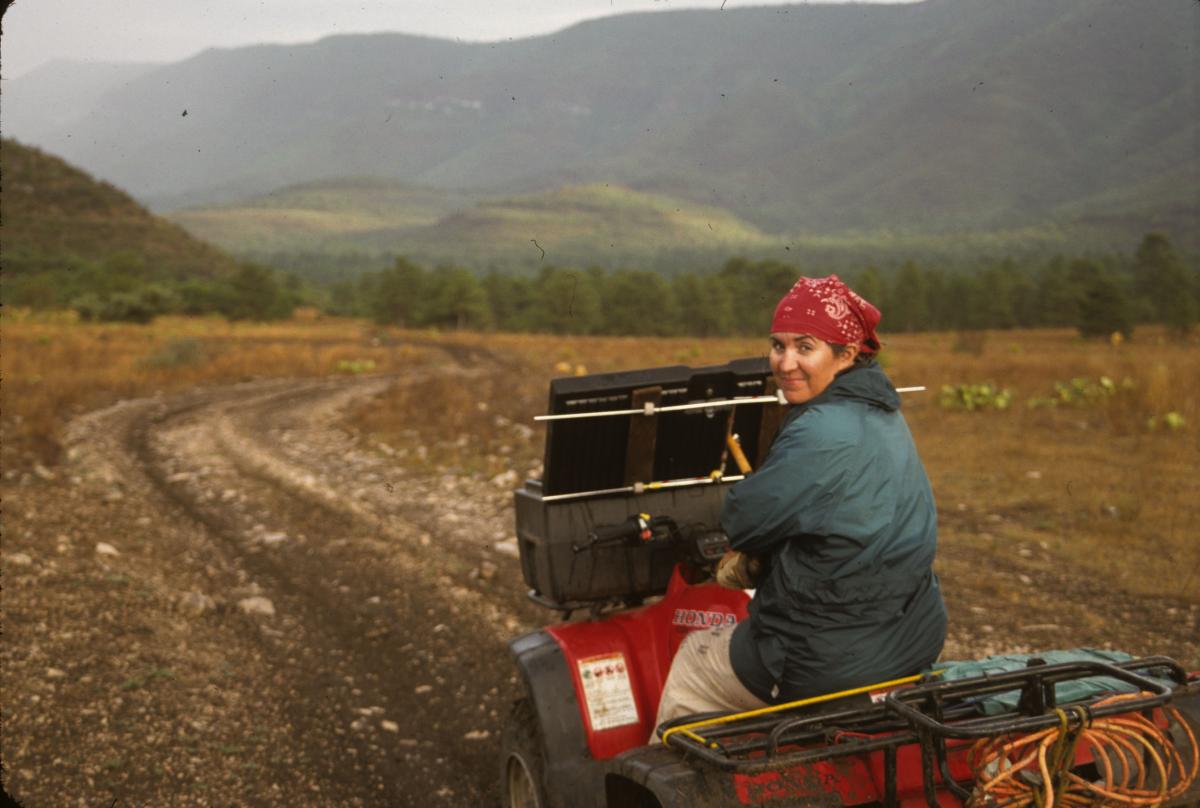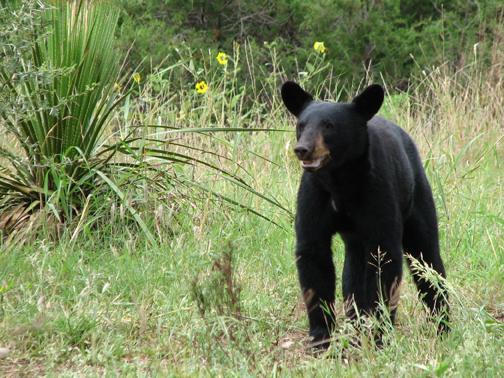While western scientists think more like a canal engineered with concrete to move water from one point to another, Indigenous people think more like a river, Diana Doan-Crider told NRT students on March 30, 2022.
“People like myself, people like Indigenous people who think very broadly, who think very holistically, think more like a river and flow outside the boundaries,” the founder of Animo Partnership in Natural Resources said. “And so, where I work now in my profession, I am working with all groups of people to encourage them to think outside the box a little bit and allow themselves to follow a more intuitive path.”
Doan-Crider is a Tepehuán Latina with Irish-Scottish ancestry whose family is from the mountains of Durango, Mexico. She wanted to study bears in Mexico and decided she needed a western college education to do so.
“I ended up moving up to University of Montana because it's kind of like the Hollywood for bear biologists,” she said. “You know, all the bear biologists are waiting tables trying to get a job in bear biology, but that's where they teach you how to work on bears.”

After graduating with her bachelor’s degree in 1990, starting her master’s degree in Texas and securing funding and equipment, Doan-Crider headed off to conduct what was to be the first quantitative bear study in Mexico.
“There were people who were observing bears for a long, long, long, long time, and there were even some biologists who were looking at bears at that time when I went back home, but none that had been conducted in a westernized fashion where we kind of came in with radio collars and did all that stuff that people do on the covers of National Geographic,” she said.
When she first arrived, she met with local landowners and cowboys to debrief on the bears. The locals gave her a long list of what they knew about the bears, including the bears’ diet in drought and rain, their movement on the land, and their average litter size, about three to four cubs a year.
Doan-Crider then spent 10 years bothering female bears in their dens and capturing and collaring about 100 bears as taught in college.
By the time the study was over, she had discovered that she could publish only about 25 percent of her findings traditionally because they were the only ones quantitatively supported. The other 75 percent of her findings came from her own observations and from the observations of the local people.
“Kind of embarrassingly, I spent all of that time and spent about a million dollars on this project to basically validate what the people who lived with the bears there already knew about them,” she said.
This led her to question her motives for going to this remote area of Mexico to do her work, and she saw mistakes she had made.
“I came there with a degree from University of Montana thinking, ‘Oh, man, I've got to go in and I'm going to teach them everything they need to know about bears,’” she said. “And the other huge mistake that I made was coming there to kind of ‘save the bears.’”

Before she had even arrived on the scene, the Mexican grizzly had been eradicated and black bears were in trouble. At the end of her study, she could look back and see that she came into it with the idea of being a rescuer.
“You could call it almost a little bit of a codependent relationship where I kind of felt like I needed to come down and rescue everybody,” she said.
Still, one thing she identified herself as doing right was she befriended locals and the military. In 3000-square kilometers of rugged bear habitat with no telephone service or hospital access, she had reached out continuously to locals and the military, bringing them small gifts and offering to pick up groceries or supplies whenever she traveled to the closest town, an eight-hour drive away.
She also followed up with locals after her study, letting them know the results.
“Oftentimes with different countries or different cultures, scientists tend to come into an area, do their research and leave,” she said. “And then these people never hear from them again, they never hear what they learned, and they never see the publication in their language or whatever. So, for the next person coming in, people aren't as willing to accept them because, again, Indigenous people or different cultures are very relational.”
Doan-Crider encouraged NRT students to develop relationships with locals to build trust and said that at 60 years old, she is as close today to the locals of the Serranias del Burro in Coahuila, Mexico, as she was when she researched bears there at 23 years old.
She said western scientists typically try to maintain objectivity by not getting friendly with subjects but this may be one of their biggest mistakes, particularly regarding climate change or Covid.
“That's where I would contradict and say, ‘You know what, we're hurting ourselves by doing that, because now people don't want to listen to what we have to say, because we haven't proven our sincerity. We haven't proven the relational side of things in many cases,’” she said.
Building relationships with locals is important for a scientist’s own safety, she said, but also for learning from locals and showing respect for them and their beliefs.
“I really respected their own cultural beliefs,” she said. “That's their deal. I'm never going to take that away from somebody, despite whether I think I'm right or not.”
Like the locals, she gleaned most of her information about bears through observations, not western scientific methods.
“One thing that I did find out there quickly was that food motivates bears to do everything that they do,” she said. “I mean, that's what they think about all the time. And being there on the landscape, watching what they ate all the time, and realizing that I was getting very little information from the radio collar material. Most of what I was learning was from watching them eat.”
She observed that acorns and water were staples of the bears’ diet and then developed calorie maps of the foods the bears ate. From that, she assessed that bears follow calories in their movements.
When it came time to publish, she managed to get her bear density estimates published in a journal, but the estimates came from a rainy time when food was available.
“If I went back and did that same density estimate the next year, I knew that bears had left because of the drought, and if I published those results as if they were fact, then I'm only creating more error,” she said. “And it was indeed a problem because I published those results back then and they're still being used today, and I know darn well that those density estimates are invalid, they're no good.”
Her publications through peer-reviewed journals were hardly reviewed by anyone because her study was on a Mexican bear population, she said.
“I realized I was speaking to an audience that wasn't listening to me, so I actually dedicated my life to speaking to other audiences, through storytelling,” she said.
Now working as a researcher at Salish Kootenai College, Doan-Crider travels a lot, presenting, and has published many articles in cattlemen’s and general interest magazines.
“Not that peer review journals should be put aside, but I do think that we need to consider who are we preaching to, because oftentimes, we're preaching to the choir, and the people who need to hear our message are not readily hearing it,” she said.
She said Indigenous people often prefer communicating though storytelling, whether the medium be film, music, social media or their own scientific publications.
“That's something that I think a lot of us can learn from our Indigenous colleagues,” she said.
And what has come of her work in the Mexican mountains years ago? Ultimately, it did gather notice. The local people launched a bear conservation program that has seen increasing numbers of black bears throughout all of Mexico, she said.
“It has become a model of how to protect and work with bears,” she said.
— Ronica Stromberg, NRT Program Coordinator


